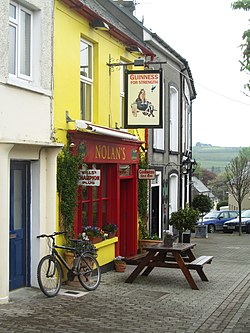Rosscarbery
| Rosscarbery Irish: Ros Ó gCairbre | |
| County Cork | |
|---|---|
 Pub in Rosscarbery | |
| Location | |
| Grid reference: | W286366 |
| Location: | 51°34’41"N, 9°1’54"W |
| Data | |
| Population: | 490 (2016) |
| Local Government | |
| Council: | Clonakilty |
| Dáil constituency: |
Cork South-West |
| Website: | www.rosscarbery.ie |
Rosscarbery is a town in County Cork, on a shallow estuary, which opens onto Rosscarbery Bay.
The name of the place is from the Irish Ros Ó gCairbre, meaning 'Cairbre's wood'.[1]
History
The area has been occupied since at least the Neolithic period, as evidenced by several Neolithic sites such as portal dolmens. The area is also home to a number of Bronze Age remains, including a number of stone circles and ring forts. There are two inscribed stones in Burgatia, and several (later) 'holy wells' nearby.
Rosscarbery was home to the School of Ross, a major centre of learning, at one time being a university town, and one of the major cities in Europe, around the 6th century. Due to its popularity as a centre of pilgrimage it was also known as Ros Ailithir ("Wood of the Pilgrims").[2] The hereditary chieftains of the area, or tuath, were the O'Learys, known as Uí Laoghaire Ruis Ó gCairbre, until it passed to Norman control in the early thirteenth century.[3] The entire region had belonged to the ancient Corcu Loígde, of whom the O'Learys were one of the leading septs.
In March 1921, during the Irish rebellion, Tom Barry's '3rd Cork Brigade' of the Irish Republican Army attacked and destroyed the Royal Irish Constabulary barracks in Rosscarbery. Two officers were killed in the attack, and nine others were injured.[4][5] There is a plaque on the site of the former barracks, beside the current Garda station, commemorating the event.[6]
Annalistic references
The Annals of Inisfallen record:
- AI924.1 Kl. 'Gothbraid (Guthfrith), grandson of Ímar (Ivar the Boneless), went by sea westwards and took the hostages of the south of Ireland by sea to Ros Ailithir.'
- AI933.2; 'Repose of Ólchobar, abbot of Ros Ailithir.'
- AI954.2; 'Repose of Dub Inse, learned bishop of Ireland, and of Cellachán, king of Caisel, and of Éladach the learned, abbot of Ros Ailithir, and of Uarach, bishop of Imlech Ibuir, and of Célechair, abbot of Cluain Moccu Nóis and Cluain Iraird, and of Cormac Ua Maíl Shluaig, learned sage of Mumu, and of Lugaid Ua Maíl Shempail, abbot of Domnach Pátraic, and of Cenn Faelad son of Suibne, anchorite of Cluain Ferta Brénainn.'
Churches

A Church of Ireland cathedral stands in the village - St Fachtna's Cathedral, which was the cathedral of the Diocese of Ross. It is the smallest cathedral in Ireland, and is the size of a typical parish church.
The diocese was merged with its neighbours in the 1860s after disestablishment, and the cathedral is now one of three in the Diocese of Cork, Cloyne and Ross.
Aa cathedral is an unusual feature for what now would be considered a sleepy country town.
The Roman Catholic church here is also known as St Fachtna's, and dates from 1820.[7]
About the village


Rosscarbery is a tourist destination in the summertime, in proximity to at least three beaches. The nearest of these, the Warren Beach, is about a mile from the village, and close by is Owenahincha beach. Extensive coastal erosion at Warren Beach resulted in remedial works being undertaken throughout 2004 and 2005.
Rosscarbery Pitch & Putt Club is located at the beach.
Antiquities
Bohonagh is a recumbent stone circle located a mile and a half east of Rosscarbery.[8] It dates from the Bronze Age and a boulder-burial is located nearby. [9]
Castle Salem is also near the town, and was the home to the Morris family from around 1660 until the early 1800s. The castle is now a guest house and run by the family who bought the castle in 1895.
Events
An annual horse fair is held in the town's square every year in August.
Sport
- Gaelic Athletics: Carbery Rangers, founded in 1887
- Rowing: Rosscarbery Rowing Club
Outside links
References
- ↑ Ros Ó gCairbre / Ross Carbery: Placenames Database of Ireland
- ↑ McNamara, Martin (2000). The Psalms in the early Irish church. Sheffield: Sheffield Academic Press. pp. 68. ISBN 9781850759256. https://archive.org/details/psalmsearlyirish00mcna.
- ↑ O'Flanagan, P. and Buttimer, C.G. Cork History and Society, Interdisciplinary Essays on the History of an Irish County, Geography Publications, Dublin 1993 p. 216
- ↑ "Home advantage – Ronan McGreevy on Tom Barry and the Rosscarbery attack". Irish Times. 22 March 2021. https://www.irishtimes.com/opinion/home-advantage-ronan-mcgreevy-on-tom-barry-and-the-rosscarbery-attack-1.4517089. Retrieved 27 October 2021.
- ↑ Leeson, DM (2011). The Black and Tans: British Police and Auxiliaries in the Irish War of Independence, 1920-1921. Oxford University Press. p. 142. ISBN 9780199598991. https://books.google.com/books?id=2h--I_CMqz8C&q=Ambrose+Shea+RIC+Bowles#v=snippet&q=Ambrose%20Shea%20RIC%20Bowles&f=false.
- ↑ "Old RIC barracks, Rosscarbery - Plaque image". Archived from the original on 2012-03-31. https://web.archive.org/web/20120331180904/http://theoldric.com/topic/587/Old-RIC-barracks-Rosscarbery-Co-Cork-2009.
- ↑ "Rosscarbery Parish". http://corkandross.org/parishes/rosscarbery-lisavaird/.
- ↑ Megalithic Portal: Bohonagh
- ↑ Weir, A (1980). Early Ireland. A Field Guide. Belfast: Blackstaff Press. p. 113.